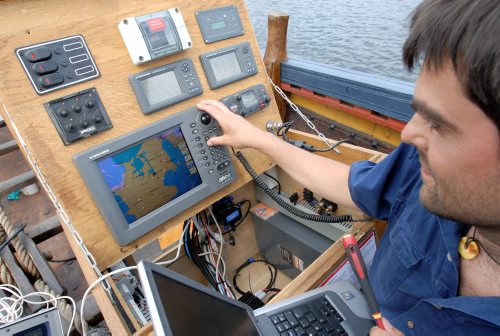The Sea Stallion’s maximum speed
The task here is to find out how fast The Sea Stallion can actually sail. Download, unzip and open the navigation data from the voyage. Go through the table and find the absolute maximum speed measured during the whole voyage or on a particular stage.
- Source criticism: What can be said of the recorded maximum speed? Is it a momentary record, which was perhaps due to the error inherent in the GPS, or due to the ship, and the GPS antenna with it, being thrown forwards by a wave? Analyse the speed in the seconds and minutes prior and subsequent to the point of maximum speed and see if it is a realistic reflection of the ship’s speed.
- Try averaging the speed over the course of, for example, 15 seconds. What is the maximum speed now?
- At which wind speed and sail setting does the ship sail fastest?
- Or conversely: What is the maximum speed with various wind speeds and various sail settings?
As a rule of thumb it is normally said that a displacement vessel (i.e. one that does not plane on top of the water) has a theoretical top speed(Vmax) in knots which is dependant on its length at the waterline (Lv1) in feet according to the formula:
Vmax = 1.34*√Lv1
- What is The Sea Stallion’s theoretical maximum speed?
- How does this correspond to the recorded top speed on the voyage?
A series of exercises has been produced which aim to analyse The Sea Stallion’s handling abilities under sail and oar power respectively. In other words, the pupil is able to carry out him- or herself much of the research which the Viking Ship Museum is to embark upon after the voyage to Dublin. The exercises are best tackled in the order shown, and it is a good idea to present the results together in a final report.
The data set to be processed comprises the ship’s geographic co-ordinates (recorded with the aid of a GPS) as well as a series of other navigational and meteorological measurements. All of this is assembled in a zipped, semicolon separated text file Datalogger which can be downloaded from Tools in the right hand column of the exercise. This table can be used as the basis for a large number of exercises involving data validation, source criticism, searching and sorting, calculations and column updates and much more. The exercises are best executed with the aid of a spreadsheet and/or GIS and can be incorporated in a wider teaching context dealing with, for example, the GPS system, statistics and cartography.
Maximum speed deals with sorting and querying of data, averaging of data and, not least, scientific source criticism! This exercise can be used in a course about GPS navigation. Use can be made of the Internet’s many good websites about the structure and function of the GPS system.
Subjects: Maths, physics, geography, general study.
Level: Sixth form/A level.
Read more
Tools
- Datalogger 14.zip
- Navigation data Roskilde-Dublin
